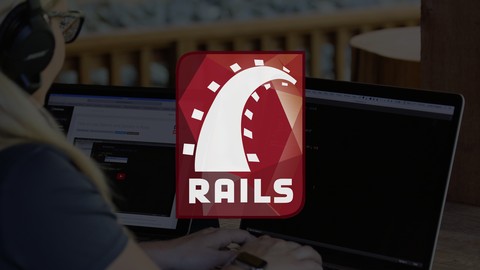
Professional Rails Code Along
Professional Rails Code Along, available at $64.99, has an average rating of 4.35, with 120 lectures, 1 quizzes, based on 631 reviews, and has 3851 subscribers.
You will learn about Build a professional grade Rails project Using Test Driven Development to develop the application Learn Rails best practices Integrate the ability to send SMS messages from an application Work with callbacks Learn how to create a full permission structure Using Capybara for automated, end to end testing Perform advanced debugging Implement Single Table Inheritance Create custom rake tasks This course is ideal for individuals who are This course covers professional development processes, a basic understanding of the Ruby on Rails framework is required to understand the material. It is particularly useful for This course covers professional development processes, a basic understanding of the Ruby on Rails framework is required to understand the material.
Enroll now: Professional Rails Code Along
Summary
Title: Professional Rails Code Along
Price: $64.99
Average Rating: 4.35
Number of Lectures: 120
Number of Quizzes: 1
Number of Published Lectures: 120
Number of Published Quizzes: 1
Number of Curriculum Items: 121
Number of Published Curriculum Objects: 121
Original Price: $29.99
Quality Status: approved
Status: Live
What You Will Learn
- Build a professional grade Rails project
- Using Test Driven Development to develop the application
- Learn Rails best practices
- Integrate the ability to send SMS messages from an application
- Work with callbacks
- Learn how to create a full permission structure
- Using Capybara for automated, end to end testing
- Perform advanced debugging
- Implement Single Table Inheritance
- Create custom rake tasks
Who Should Attend
- This course covers professional development processes, a basic understanding of the Ruby on Rails framework is required to understand the material.
Target Audiences
- This course covers professional development processes, a basic understanding of the Ruby on Rails framework is required to understand the material.
Hi and welcome to the Professional Rails Code Along Course, where I will walk through how to build a real world Ruby on Rails project that I was hired by a client to develop. My name is Jordan Hudgens, and I’ll be your instructor for the course. I’ve built many different Ruby on Rails applications throughout the past few years for companies such as Eventbrite and Quip and one of my passions is helping individuals learn how to code.
After completing this course you will be able to build a production Rails project from scratch. But there are a million courses that will help you do that. What makes this course different is that you’ll learn how to build a Rails application like a professional developer. I took a completely different approach to creating this course. I don’t edit any mistakes and I filmed the entire set of videos in real time so you can watch my exact process when I am tasked with building a real world application. I made this decision so that you can get a transparent view into what it takes to become a pro developer, and also so you can see how I work through challenges, all in real time.
One of the most critical requirements for a professional Rails developer is a strong knowledge of testing. With that in mind, every feature that we build in the course will be created with the test driven development process. Some of the key features you’ll learn how to implement are:
- Using TDD and BDD with the RSpec and Capybara testing frameworks
- Working with the Twilio API to send SMS messages
- Integrating a permission structure for users
- Implementing an administrator dashboard
- Working with automated email components
- Creating an approval workflow from scratch
- Creating JavaScript Growl notifications
- And much more!
This course is not for the faint of heart. The ideal student for this project is someone who has already taken a basic Rails course and wants to take their skill to the professional level.
Each lesson comes paired with the source code implemented at that stage so that you can follow along and compare your code with the codebase for the application. And beyond that you can also use the source code to extend it and build your own production applications.
Please feel free to review the course curriculum and I look forward to going through the material with you on your development journey!
Course Curriculum
Chapter 1: Planning the Application We're Going to Build
Lecture 1: The Application We'll Build in the Course
Lecture 2: Source code for the Application
Lecture 3: Project Requirements Planning
Chapter 2: Initial Application Build
Lecture 1: Creating the App
Lecture 2: Pushing the Application to a Remote GitHub Repository
Lecture 3: Installing RSpec and Capybara Testing Frameworks
Lecture 4: Using BDD to Build a Homepage
Chapter 3: Creating a User with Test Driven Development
Lecture 1: Installing and Configuring Authentication
Lecture 2: Creating an Admin User Type Using Single Table Inheritance
Lecture 3: Implementing Data Validations via Test Driven Development
Chapter 4: Implementing the Ability to Post Overtime Requests
Lecture 1: How to Use the Resource Generator for Posts
Lecture 2: Creating an Index View Using Behavior Driven Development via Capybara
Lecture 3: Creating a Seeds File to Generate Sample Data
Lecture 4: Using BDD to Create Posts and Implement CRUD
Lecture 5: Refactoring the Post Creation Process
Lecture 6: Building a Relational Connection Between Users and Posts
Chapter 5: Integrate an HTML/CSS Design and Layout
Lecture 1: How to Implement the Twitter Bootstrap HTML/CSS Framework
Lecture 2: Integrate the Basic HTML Layout
Lecture 3: Creating a Rails Helper Method for Activating the Navigation Tabs
Chapter 6: Listing Posts via Test Driven Development
Lecture 1: Rending a List of Posts via BDD
Lecture 2: Refactoring the Index Action to Follow Best Practices
Lecture 3: How to Create a Custom Model Method to Generate a User's Full Name
Chapter 7: Installing FactoryGirl for Test Data
Lecture 1: Installing FactoryGirl for Test Data Creation
Lecture 2: How to Refactor Tests to Include Factories
Chapter 8: Implementing New CRUD Functionality into the Application
Lecture 1: Implement Ability to Edit Posts via BDD
Lecture 2: Adding a Button to Create Posts
Lecture 3: Integrating the Ability to Delete Posts
Chapter 9: Building Advanced User Interface Elements
Lecture 1: How to Style the Application Forms
Lecture 2: Implement Growl Notifications to Alert Users
Lecture 3: How to Implement Growl Notifications for Form Validations
Lecture 4: How to Style the Sign In Forms
Chapter 10: Installing and Customizing the Admin Dashboard
Lecture 1: Removing the Ability for Users to Register
Lecture 2: Installing the Admin Dashboard via the Administrate Gem
Lecture 3: How to Customize Administrate Admin Dashboard Forms
Lecture 4: Customizing the Admin Dashboard Search Engine
Lecture 5: Blocking Non Admins from Accessing the Admin Dashboard
Chapter 11: Building out the Approval Workflow
Lecture 1: Planning the Approval Workflow Feature
Lecture 2: Implementing the Enum Component to Track Workflow Statuses
Lecture 3: Customizing the Admin Dashboard to Show Approval Statuses
Lecture 4: How to Implement Radio Buttons via BDD
Lecture 5: Hiding Approval Form Elements from Non Admins
Lecture 6: How to Hide Navigation Bar Elements from Users that Aren't Signed In
Chapter 12: Creating a Permission Structure to Manage App Authorization
Lecture 1: Installing Pundit for Application Permission Structure
Lecture 2: Implementing Post Permissions
Lecture 3: Implementing RSpec Tests for Permissions, Part 1
Lecture 4: Implementing RSpec Tests for Permissions, Part 2
Lecture 5: Adding Growl Notifications for Permission Alerts
Lecture 6: Integrating Permission Structures to Hide Posts from Non Authorized Users Part 1
Lecture 7: Integrating Permission Structures to Hide Posts from Non Authorized Users Part 2
Chapter 13: Building Advanced Features in Rails
Lecture 1: How to Build a Custom Database Query Scope in Rails
Lecture 2: Refactoring the Integration Test Post Spec
Lecture 3: How to Lock Records in Rails
Lecture 4: Creating a Custom View Helper to Render Color Coded Labels
Lecture 5: Hiding Elements in the View Based on the Permission Structure
Lecture 6: Installing and Running the Puma Web Server
Lecture 7: Adding Overtime Hours to Posts with Validations
Lecture 8: Updating Integration Tests to Include Requested Overtime Hours
Lecture 9: Styling the Show Page View Template
Lecture 10: Integrating Icons into the Views for Edit and Delete Components
Chapter 14: Implementing the Twilio API for Sending Text Messages
Lecture 1: Installing the Twilio API Gem
Lecture 2: Protecting API Credentials via the Dotenv Rails Gem
Lecture 3: Building the SMS Tool Module
Lecture 4: Creating a RSpec Stub for Sending SMS Messages
Chapter 15: Creating a Custom Rake Task
Lecture 1: Building a Custom Rake Task
Lecture 2: Planning the SMS Rake Task Data Flow
Lecture 3: Adding a Phone Number to Users with Validations
Lecture 4: Implement Regular Expression Matcher for Phone Numbers
Lecture 5: Finalize the Ability to Send Text Messages
Chapter 16: Building the Audit Log Functionality
Lecture 1: Planning the Audit Log Functionality
Lecture 2: Generating the Audit Log Feature Using the Resource Generator
Lecture 3: Creating a Factory for the Audit Log Using FactoryGirl
Lecture 4: Integrating Data Validations with RSpec Tests
Lecture 5: Updating the Seeds File for Accurate Sample Data
Lecture 6: Implementing a Tab for the Audit Log Dashboard only Shown to Admin Users
Lecture 7: Building the Initial Audit Log Dashboard
Lecture 8: Blocking Non Admins from the Audit Log Index Page
Lecture 9: Styling the Audit Log Dashboard
Lecture 10: Implementing the Status Enum and Label Generator for Audit Items
Chapter 17: Implementing AJAX Based Pagination
Lecture 1: Integrating Pagination with Kaminari Gem
Lecture 2: Styling Pagination Throughout the Application
Lecture 3: Building AJAX Based Pagination Using JavaScript Calls
Chapter 18: Building out a Monitoring Dashboard for Managers
Lecture 1: Structuring the Page Flow for Admins vs Employees
Instructors
-
Jordan Hudgens
CTO at Bottega Code School
Rating Distribution
- 1 stars: 5 votes
- 2 stars: 13 votes
- 3 stars: 28 votes
- 4 stars: 187 votes
- 5 stars: 398 votes
Frequently Asked Questions
How long do I have access to the course materials?
You can view and review the lecture materials indefinitely, like an on-demand channel.
Can I take my courses with me wherever I go?
Definitely! If you have an internet connection, courses on Udemy are available on any device at any time. If you don’t have an internet connection, some instructors also let their students download course lectures. That’s up to the instructor though, so make sure you get on their good side!
You may also like
- Top 10 Financial Technology Courses to Learn in December 2024
- Top 10 Agile Methodologies Courses to Learn in December 2024
- Top 10 Project Management Courses to Learn in December 2024
- Top 10 Leadership Skills Courses to Learn in December 2024
- Top 10 Public Speaking Courses to Learn in December 2024
- Top 10 Affiliate Marketing Courses to Learn in December 2024
- Top 10 Email Marketing Courses to Learn in December 2024
- Top 10 Social Media Management Courses to Learn in December 2024
- Top 10 SEO Optimization Courses to Learn in December 2024
- Top 10 Content Creation Courses to Learn in December 2024
- Top 10 Game Development Courses to Learn in December 2024
- Top 10 Software Testing Courses to Learn in December 2024
- Top 10 Big Data Courses to Learn in December 2024
- Top 10 Internet Of Things Courses to Learn in December 2024
- Top 10 Quantum Computing Courses to Learn in December 2024
- Top 10 Cloud Computing Courses to Learn in December 2024
- Top 10 3d Modeling Courses to Learn in December 2024
- Top 10 Mobile App Development Courses to Learn in December 2024
- Top 10 Graphic Design Courses to Learn in December 2024
- Top 10 Videography Courses to Learn in December 2024






















